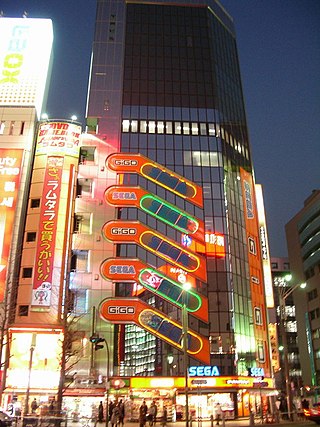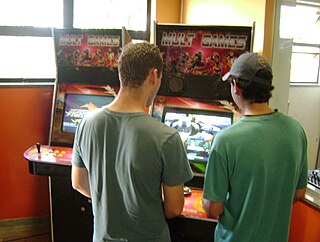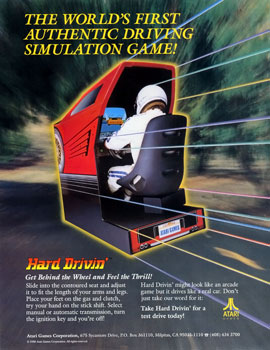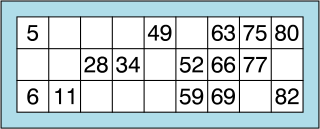
A slot machine, fruit machine, poker machine or pokies is a gambling machine that creates a game of chance for its customers. Slot machines are also known pejoratively as one-armed bandits because of the large mechanical levers affixed to the sides of early mechanical machines and the games' ability to empty players' pockets and wallets as thieves would.

Pachinko (パチンコ) is a mechanical game originating in Japan that is used as an arcade game, and much more frequently for gambling. Pachinko fills a niche in Japanese gambling comparable to that of the slot machine in the West as a form of low-stakes, low-strategy gambling.

An amusement arcade, also known as a video arcade, amusements, arcade, or penny arcade, is a venue where people play arcade games, including arcade video games, pinball machines, electro-mechanical games, redemption games, merchandisers, or coin-operated billiards or air hockey tables. In some countries, some types of arcades are also legally permitted to provide gambling machines such as slot machines or pachinko machines. Games are usually housed in cabinets.

In the United States, bingo is a game of chance in which each player matches the numbers printed in different arrangements on cards. The game host (caller) draws at random, marking the selected numbers with tiles. When a player finds the selected numbers are arranged on their card in a row, they call out "Bingo!" to alert all participants to a winning card, which prompts the game host to examine the card for verification of the win. Players compete against one another to be the first to have a winning arrangement for the prize or jackpot. After a winner is declared, the players clear their number cards of the tiles and the game host begins a new round of play.

WMS Industries, Inc. was an American electronic gaming and amusement manufacturer in Enterprise, Nevada. It was merged into Scientific Games in 2016. WMS's predecessor was the Williams Manufacturing Company, founded in 1943 by Harry E. Williams. However, the company that became WMS Industries was formally founded in 1974 as Williams Electronics, Inc.

An arcade cabinet, also known as an arcade machine or a coin-op cabinet or coin-op machine, is the housing within which an arcade game's electronic hardware resides. Most cabinets designed since the mid-1980s conform to the Japanese Amusement Machine Manufacturers Association (JAMMA) wiring standard. Some include additional connectors for features not included in the standard.

An electronic game is a game that uses electronics to create an interactive system with which a player can play. Video games are the most common form today, and for this reason the two terms are often used interchangeably. There are other common forms of electronic game including handheld electronic games, standalone systems, and exclusively non-visual products.

A pub game is one which is traditionally played inside or outside a pub or bar. Most pub games date back many years and are rooted in village culture. Many derive from older outdoor sports.

Hard Drivin' is a driving simulation video game developed by Atari Games in 1989. It invites players to test drive a sports car on courses that emphasize stunts and speed. The game features one of the first 3D polygon driving environments via a simulator cabinet with a force feedback steering wheel and a custom rendering architecture. According to the in-game credit screen, Hard Drivin' was designed by two teams working concurrently in the United States and Ireland.
A pay table is the name for the list of payouts on a slot machine or video poker machine. The table shows for each combination of symbols and the number of coins bet how many coins the bettor will win. The pay table feature of the slot machine displays all possible winning sequences for that specific slot game.

A pull-tab is a gambling ticket for a pull-tab game. Other names for the game include Break-Opens, Nevada Tickets, Cherry Bells, Lucky 7s, Pickle Cards, Instant Bingo, Bowl Games, or Popp-Opens.

Prize Bingo is a game derived from standard Bingo games which is particularly popular in UK seaside resorts. Rather than winning cash prizes as per normal bingo, Prize Bingo instead offers points to the winner of each game which can be redeemed in a dedicated shop near to or within the Prize Bingo area although some games reward players with free games or tokens.

Medal games are a type of arcade game commonly found in amusement arcades and casinos, especially in Japan. In order to play a medal game, a customer must first exchange their cash into medals. The rate of medals versus cash varies from arcade to arcade, but usually the cheapest range is from ¥300 all the way up to ¥10,000.

Bingo is a game of probability in which players mark off numbers on cards as the numbers are drawn randomly by a caller, the winner being the first person to mark off all their numbers. Bingo, also previously known in the UK as Housey-Housey, became increasingly popular across the UK following the Betting and Gaming Act 1960 with more purpose-built bingo halls opened every year until 2005. Since 2005, bingo halls have seen a marked decline in revenues and the closure of many halls. The number of bingo clubs in Britain has dropped from nearly 600 in 2005 to under 400 as of January 2014. These closures are blamed on high taxes, the smoking ban, and the rise in online gambling, amongst other things.

Slot machine terminology, characteristics and regulations vary around the world.

Dragon's Lair is an interactive film LaserDisc video game developed by Advanced Microcomputer Systems and published by Cinematronics in 1983, as the first game in the Dragon's Lair series. In the game, the protagonist Dirk the Daring is a knight attempting to rescue Princess Daphne from the evil dragon Singe who has locked the princess in the foul wizard Mordroc's castle. It featured animation by ex-Disney animator Don Bluth.

The Groove Coaster series is an iOS / Android and arcade rhythm game franchise developed by Matrix Software and published by Taito. The first Groove Coaster was released for iOS on July 28, 2011. This rhythm game follows a roller coaster type track on screen, where players must make the appropriate controller inputs. Like many rhythm games, a life bar is attached to the game play. Players gain or lose points on the bar depending on the input timings.

Periscope is an electro-mechanical arcade shooting submarine simulator. Two companies developed similar games with the name. The first, initially called Torpedo Launcher, was designed by Nakamura Manufacturing Co. and released in Japan in 1965, as the first arcade game Masaya Nakamura built. Sega Enterprises, Ltd. also built and released Persicope in Japan in 1966, as one of its first produced arcade games.

An arcade game or coin-op game is a coin-operated entertainment machine typically installed in public businesses such as restaurants, bars and amusement arcades. Most arcade games are presented as primarily games of skill and include arcade video games, Pinball machines, electro-mechanical games, redemption games or merchandisers.


















